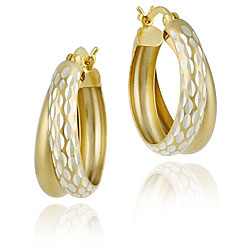Common locations for piercings, other than the earlobe, include the rook, tragus, and across the helix (see image at right). The simple term "ear piercing" usually refers to an earlobe piercing, whereas piercings in the upper part of the external ear are often referred to as "cartilage piercings". Cartilage piercings are more complex to perform than earlobe piercings and take longer to heal.
Earring components may be made of any number of materials, including metal, plastic, glass, precious stone, beads, wood, bone, and other materials. Designs range from small loops and studs to large plates and dangling items. The size is ultimately limited by the physical capacity of the earlobe to hold the earring without tearing. However, heavy earrings worn over extended periods of time may lead to stretching of the earlobe and the piercing.
History
|
|
This section includes a list of references, but its sources remain unclear because it has insufficient inline citations. (April 2008) |
Other early evidence of earring-wearing is evident in the Biblical record. In Exodus 32:1–4, it is written that while Moses was up on Mount Sinai, the Israelites demanded that Aaron make a god for them. It is written that he commanded them to bring their sons' and daughters' earrings (and other pieces of jewelry) to him in order that he might comply with their demand. (ca. 1500 BCE)
Earrings became fashionable among courtiers and gentlemen in the 1590s during the English Renaissance. A document published in 1577 by clergyman William Harrison, Description of England, states "Some lusty courtiers and gentlemen of courage do wear either rings of gold, stones or pearls in their ears." Among sailors, a pierced earlobe was a symbol that the wearer had sailed around the world or had crossed the equator. In addition, it is commonly held that a gold earring was worn by sailors in payment for a proper burial in the event that they might drown at sea. Should their bodies have been washed up on shore, it was hoped that the earring would serve as payment for "a proper Christian burial". Regardless of this expression, the practice predates Christianity and can be traced back as far as ancient Greece where the gold paid the ferryman, Charon, to provide passage across the river Styx to Hades.
In the late 1960s, ear piercing began to make inroads among men through the hippie and gay communities. At that time, the practice re-emerged, but since a large commercial market for them did not exist, most ear piercings were done at home.Teenage girls were known to hold ear piercing parties, where they performed the procedure on one another. Such an event is depicted in the 1978 motion picture Grease (set in 1959), where Sandy (Olivia Newton-John), the leading lady, is pierced by her friends.
In the late 1970s, amateur piercings, sometimes with safety pins and/or multiple piercings, became popular in the punk rock community. By the 1980s, the trend for male popular music performers to have pierced ears helped establish a fashion trend for men. This was later adopted by many professional athletes. British men started piercing both ears in the 1980s; George Michael of Wham! was a prominent example. The heavily jeweled Mr. T was an early example of an American celebrity wearing earrings in both ears, although this trend did not become popular with mainstream American men until the 1990s.
Multiple piercings in one or both ears first emerged in mainstream America in the 1970s. Initially, the trend was for women to wear a second set of earrings in the earlobes, or for men to double-pierce a single earlobe. Asymmetric styles with more and more piercings became popular, eventually leading to the cartilage piercing trend.
A variety of specialized cartilage piercings have since become popular. These include the tragus piercing, antitragus piercing, rook piercing, industrial piercing, helix piercing, orbital piercing, daith piercing, and conch piercing. In addition, earlobe stretching, while common in indigenous cultures for thousands of years, began to appear in Western society in the 1990s, and is now a fairly common sight. However, these forms of ear piercing are still infrequent compared to standard ear piercing.
Procedure
Ear piercing became commonly available in physician offices.Some of the earliest commercial, non-medical locations for getting an ear piercing appeared in the 1960s at Manhattan jewelry stores, although the overall commercial market was still in its infancy. By the 1980s, ear piercing was common among many women, thus creating a broader market for the procedure. Department stores throughout the country would hold ear piercing events, sponsored by earring manufacturers. At these events, a nurse or other trained person would perform the procedure, either pushing a sharpened and sterilized starter earring through the earlobe by hand, or using an ear-piercing instrument modified from the design used by physicians.Religious
In India, nearly all the girls and some boys get their ears pierced in a religious ceremonybefore they are about 5 years old. Infants may get their ears pierced as early as several days after their birth.Similar customs are practiced in other Southeast Asian countries, including Nepal, Sri Lanka, and Laos, although traditionally most males wait to get their ears pierced until they have reached young adulthood. They only tend to allow one piercing on each ear as it is disrespectful to have any more than that.
Health risks
The health risks with conventional earlobe piercing are common but tend to be minor, particularly if proper technique and hygienic procedures are followed. One study found that up to 35% of persons with pierced ears had one or more complications, including minor infection (77% of pierced ear sites with complications), allergic reaction (43%), keloids (2.5%), and traumatic tearing (2.5%).Pierced ears are a significant risk factor for contact allergies to the nickel in jewelry.Earlobe tearing, during the healing period or after healing is complete, can be minimized by not wearing earrings, especially wire-based dangle earrings, during activities in which they are likely to become snagged, such as while playing sports. Also, larger gauge jewellery will lessen the chance of the earring being torn out.With cartilage piercing, the blunt force of an ear piercing instrument will traumatize the cartilage, and therefore make healing more difficult. Also, because there is substantially less blood flow in ear cartilage than in the earlobe, infection is a much more serious issue. There have been several documented cases of severe infections of the upper ear following piercing with an ear piercing instrument, which required courses of antibiotics and/or surgery to clear up. There are many ways that an infection can occur: the most common way is when the person that got pierced decides to take out the piercing too early. According to the A.M.A,the proper waiting period to change or take out a piercing with substantially less risk of infection would be three weeks.
For all ear piercings, the use of a sterilized hollow piercing needle tends to minimize the trauma to the tissue and minimize the chances of contracting a bacterial infection during the procedure. As with any invasive procedure, there is always a risk of infection from blood borne pathogens such as hepatitis and HIV. However, modern piercing techniques make this risk extremely small (the risk being greater to the piercer than to the pierced due to the potential splash-back of blood). There has never been a documented case of HIV transmission due to ear/body piercing or tattooing, although there have been instances of the Hepatitis B virus being transmitted through these practices.







































No comments:
Post a Comment